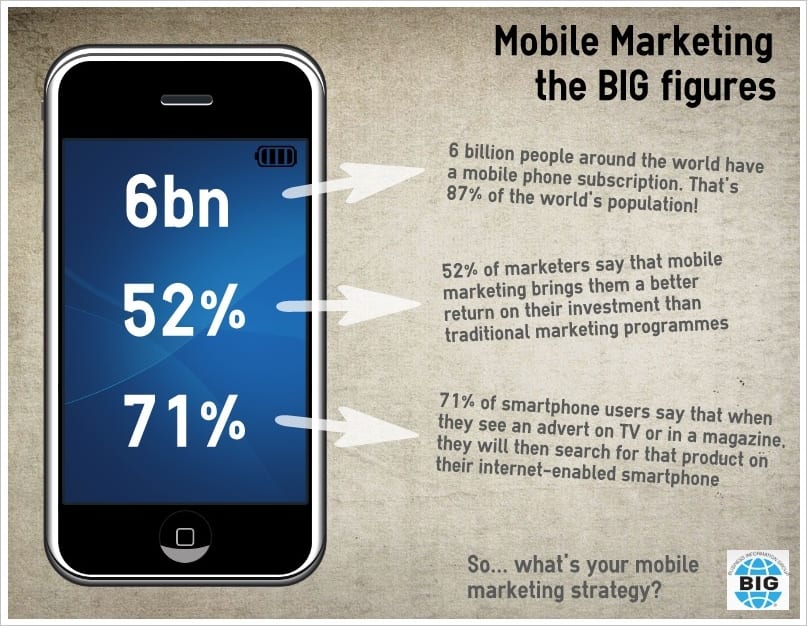If there’s one thing that ties us all together, it’s ownership of a mobile phone. As smartphones become more or less the norm, the growth of mobile marketing is phenomenal, and its potential almost unknown. As the infographic shows, 6 billion people have mobile phones, which represents 87% of the world’s population.
And what are we doing on those mobile phones? We’re consuming. We’re consuming media, we’re buying digital goods, we’re searching, we’re paying bills, we’re finding services… the mobile phone has not replaced the laptop or the PC, it is supplementing it.
Indeed, for many people, the mobile phone has become transactional. 52% of marketers report that they are experiencing greater ROI through mobile marketing than through any other medium. That’s a huge step forward in mobile marketing. We’ve jumped from the rabbit-in-the-headlights moment to actually making a return on investment. With 48% of mobile owners admitting that mobile marketing influences their purchasing decisions, it’s time to act (if you haven’t already).
Related: Five Key Elements Of A Successful Mobile Marketing Campaign
Mobile best practice – being responsive?
Let’s start with websites, as mobile marketing is often driven through websites, or is initiated through search. Do you measure your percentage of visitors on mobile phones? If not, it may be worth doing so through your web analytics package. If that percentage is low, do not automatically think that your mobile readership is automatically low – they may just not be able to find you.
Now, checking those metrics, look at engagement figures. Compare PC and Mobile stats such as bounce rate, time on page, pages per visit. On one website I own, I observed a single page per visit metric, with a 90% bounce rate (or greater), and decided I had to act.
This being a Wordpress site, I simply changed the theme. However, the theme had to be responsive, which means that the website changes itself depending on browser size. This means that the site is automatically optimised for laptop, tablet and mobile phones without any risk of duplicate content that is inherent in having a separate mobile website.
Responsive websites may take a little more time to develop, and a little more effort, but they meet the demand of today’s mobile web user. And don’t think that it’s just in B2C. For example, in a B2B world, an executive may be given the task of searching for a supplier. That search will take place on a laptop, but the recommendation may come through to a line manager on a Blackberry, who will forward the e-mail to the decision-maker who is using an iPad. Three different browsers, three different people, three different experiences. You want to be present on all three, with the minimum amount of fuss.
Innovation sparks engagement
71% of UK consumers say they’re expecting to make a purchase through their mobile phone over the next 12 months, and that number is rising. The key takeaway for mobile marketers is to make it easy.
Clearly, poor web experiences or apps that don’t work are going to create resentment and a negative brand experience. However, mobile marketing is a great opportunity to innovate and try something different – something tied to the mobile user experience, such as:
– using geo-location capabilities to target your offering
– using mobiles to make in-store purchases
– using QR codes to create an engaging experience (e.g. Macy’s)
People find using their mobile phones fun, so build your mobile marketing campaign around that idea. It should be fun and simple, and while integrated with your other marketing efforts, should be a standalone. The more you use mobile technology such as geo-location in your efforts, the more likely you are to see increased take-up.
Related: Checklist: Is Your Website Mobile Ready?
Even the big boys do simple things
Coca-Cola have been running an SMS marketing campaign since 2006, and it’s incredibly simple. Customers just text codes they find beneath the lids of bottles, and accumulate points in order to win prizes.
This repeated engagement encourages further purchases, increases engagement with the brand, and dare I say it, reduces the likelihood of them buying Pepsi in future. It’s just an SMS, but as a campaign, it’s huge. Over five years’ worth of SMS marketing have proved invaluable for Coke.
Starbucks have used coupons in the past, but they are now branching out into payment by mobile phone in branches. Given that most Starbucks customers will probably have iPhones (just a hunch), the strategy is blindingly obvious to many, but its simplicity is what really drives it.
Simple things, at low cost, can bring phenomenal ROI.
And that, ultimately, is the lesson for everyone here – if mobile marketing has passed you by, it’s never too late to try something simple, something innovative. It doesn’t have to cost the earth, it just has to use mobile technology in a way that engages people. Whatever you do, whatever you sell, your customers have mobile technology in their pockets: use it.
Did you like this article? Sign up for our RSS, like us on Facebook or follow us on Twitter


